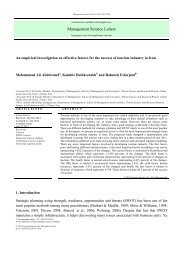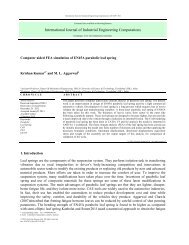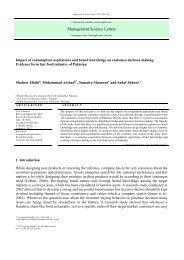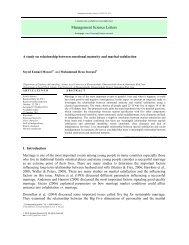PDF (276 K) - Growing Science
PDF (276 K) - Growing Science
PDF (276 K) - Growing Science
Create successful ePaper yourself
Turn your PDF publications into a flip-book with our unique Google optimized e-Paper software.
326<br />
the third component takes into account the holding cost of all jobs which are waiting to be processed<br />
as works in process. Equality (2) guarantees that the number of positions in which job i is processed<br />
is equal to the processing time of job i. Inequality (3) necessitates that in each position only one job is<br />
processed. The tardiness and earliness of each job are calculated by Constraints (4) and (5).<br />
Constraints (6) and (7) provide the logical binary and non-negativity integer necessities for the<br />
decision variables. Eq. (8) and Eq. (9) present the completion time and starting time of each job,<br />
respectively. In the following, the components of objective Fig 1 shows an example to illustrate the<br />
calculation way of earliness and tardiness in the first component of objective function and related<br />
constraints (4) and (5). As we can see, the completion time of job 1 (C1) happens after its due date<br />
(D1 c ). As a result, tardiness of job 1 happens and its value is equal to T1 = C1 - D1 c . Also, the starting<br />
time of job 1 (S1) happens before its ideal starting time (D1 s ). Therefore, earliness of job 1 happens<br />
and its value is equal to E1 = D1 s - S1. The cost resulted from E/T is obtained by product unitary E/T<br />
penalty and the related E/T quantities.<br />
S 1<br />
E 1= D 1 S -S1<br />
I 1<br />
D1 S<br />
C 1<br />
1 6<br />
Fig. 1. Earliness and Tardiness cost<br />
In the second component of objective function, the interruption cost is calculated by product the<br />
number of interruptions on the machine and the unitary interruption penalty. By considering that<br />
variable Xij is binary, one of the following situations will happen in term 1 J −<br />
∑ X ij − X ij + 1 of the<br />
second component of objective function:<br />
1. If X ij = 1 and 1 1 X ij + = , the absolute term returns 0 as the result which implies job i in<br />
positions j and j+1 is processed on machine without any interruption.<br />
2. If X ij = 1 and X ij + 1 = 0 , the absolute term returns 1 as the result which implies job i is<br />
processed in position j but not in position j+1. Therefore, an interruption happens between<br />
positions j and j+1 for job i.<br />
3. If X ij = 0 and 1 1 X ij + = , the absolute term returns 1 as the result which implies job i is not<br />
processed in position j but in position j+1. Therefore, an interruption happens between<br />
positions j and j+1 for job i.<br />
4. If X ij = 0 and X ij + 1 = 0 , the absolute term returns 0 as the result which implies job i in<br />
positions j and j+1 is not processed on machine. Therefore, there is no interruption between<br />
positions j and j+1 for job i.<br />
If the starting position in which job i starts to be processed is any position except the beginning<br />
position 1, term 1 J −<br />
X − X takes into account an interruption while it doesn’t happen in reality.<br />
∑<br />
j = 1<br />
ij ij + 1<br />
Similarly, if the final position in which job i completes its process is any position except the ending<br />
J −1<br />
position J, term ∑ X ij − X ij + 1 takes into account an interruption while it doesn’t happen in reality.<br />
j = 1<br />
I1<br />
D1<br />
T1=C1 -D1 c<br />
To overcome this fault in calculating the number of interruptions, 2 units are subtracted from<br />
J −1<br />
∑ X ij<br />
j = 1<br />
− X ij + 1 . Since for a job variables i 1<br />
I1<br />
Position<br />
j = 1<br />
X or X iJ may be equal to 1 that means the job is








